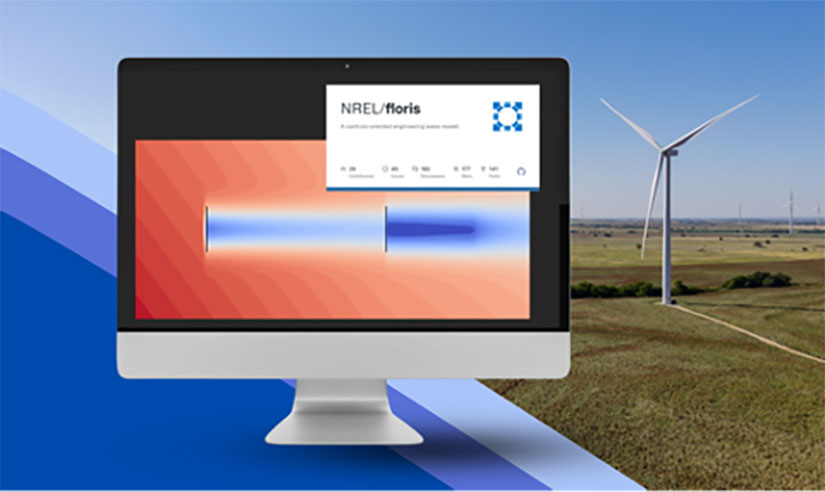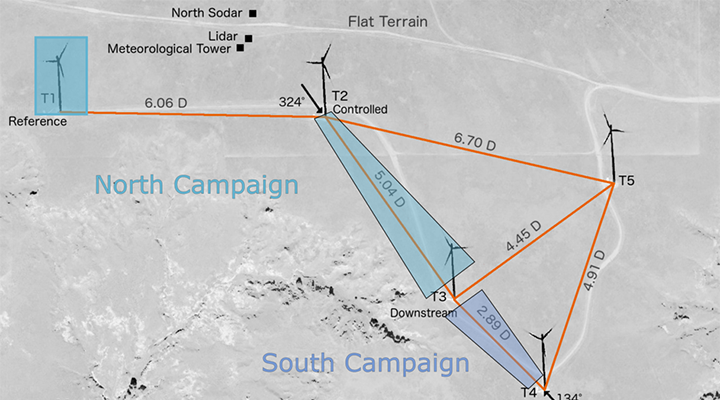FLORIS: FLOw Redirection and Induction in Steady State
FLOw Redirection and Induction in Steady State (FLORIS) is an open-source wind plant optimization tool complemented by the FLORIS-based Analysis for Supervisory Control and data acquisition (FLASC) tool.

NREL's capabilities in wind farm control span the process of designing, implementing, and validating wind farm controllers. NREL's real-time wind farm control strategies enable entire plants to adjust to changing wind directions and other conditions via data sharing among turbines.
An essential tool on GitHub, FLORIS enables existing wind energy facilities to improve productivity and future projects to maximize profits by optimizing flow control strategies, like wake steering. At NREL, researchers use FLORIS to help our partners develop site-specific, optimized flow control strategies that increase productivity, and the tool's performance analysis capabilities demonstrate the impacts of implementing controls and identify potential areas for improvement.
A companion, open-source software on GitHub FLASC debuted debuted in March 2022. FLASC provides a rich suite of analysis tools for SCADA data filtering, analysis, wind farm model validation, field experiment design, and field experiment monitoring.

The latest version of the open-source FLORIS platform is available for download and collaborative development on GitHub. In addition, NREL's flow control experts are accessible to academia, manufacturers, developers, and small businesses through multiple partnering formats.
FLORIS is developed by NREL and Delft University of Technology with support from the U.S. Department of Energy Wind Energy Technologies Office. Funding was also provided by the National Offshore Wind Research and Development Consortium.
Latest Version
The latest updates were released in April 2024 for FLORIS version 4.0 (v4.0) and FLASC version 2.0. These major improvements and updates increase the tools’ capabilities and improve user experience.
FLORIS v4.0 updates include:
Enhanced Code Base and API for Improved Performance and Flexibility
The code base and API have been completely reworked for improved clarity, performance, and extensibility. The code was streamlined to work in a clear, consistent, and seamless way across use cases, including time-series data and wind-rose data. These changes make FLORIS more user-friendly and facilitates easier integration with new features and modules.
Introduced New Time Series and WindRose Objects
New objects Time Series and WindRose are introduced which can hold wind conditions, and related information such as frequency tables and market values. These objects can be used to drive in a convenient way many of FLORIS’ main operations.
Revamped Turbine Operations Allowings for Derating and Helix Control
The representation of wind turbines has been revamped in FLORIS 4.0 to allow more flexible definitions of turbine operation. This enables both derating and Helix control, as well as providing an entry point for future models on turbine performance under yaw misalignment and other wake mixing strategies. FLORIS 4.0 introduces a simple model for the "helix" active wake mixing wind farm control strategy. This strategy uses individual pitch actuation to enhance wake recovery and maximize wind farm power production. Additionally, FLORIS 4.0 includes the ability to provide a derating setpoint for wind turbines, as well as the ability to shut off individual turbines entirely for specific times or conditions, as well as to apply derating control to wind turbines. These new modes expand FLORIS' capabilities to model observed wind farm data.
Enhanced Layout Optimization With Market Value Information
FLORIS can now incorporate electricity market value information as a function of time or wind condition, enabling more sophisticated layout and control optimizations that consider revenue in addition to energy production. This feature enhances FLORIS' utility for real-world wind plant design and operation scenarios.
Added a Turbulence Intensity Array for Precise Wind Conditions
Instead of being specified as a single value, turbulence intensity is now defined as an array, allowing different turbulence values for each wind direction and wind speed condition run. Turbulence intensity can additionally be derived as a function of wind speed and direction.
Included Absolute Power Performance Specifications
The power performance of a wind turbine as a function of wind speed is now specified in absolute terms (kW) rather than as a power coefficient (Cp, unitless). This change reflects the turbine specifications more commonly available from manufacturers, as well as solving issues with the above-rated power curve in previous versions. Utilities have been provided to convert FLORIS v3 turbine models to v4.
Updated Reference Turbines
The reference turbines provided with FLORIS (NREL 5MW, IEA 10MW, and IEA 15MW) have been updated to match the latest publicly available power and thrust curves.
Expanded Control Modes For Better Wind Farm Modeling
Multidimensional turbine power and thrust curves were implemented in FLORIS v3.5 but were limited to use with a specific wake model. In FLORIS v4.0, multidimensional turbines are compatible with all wake and turbine operation models.
Improved User Experience With Revamped Examples and Documentation
Terminology has been updated for greater clarity. User-facing examples and documentation have been revamped and improved making it easier for users to understand and utilize FLORIS. User examples have also been added to the FLORIS documentation on GitHub.
For installation and upgrade instructions, refer to the installation section in theinstallation documentation on GitHub.
Another software update from the NREL controls team is FLASC 2.0, which is designed to synchronize with the advancements in FLORIS 4.0 and to capitalize on its new features. This version of FLASC also includes enhancements to code clarity and is a major release.
The FLASC documentation on GitHub has instructions on upgrading your local installation.
These updates build on FLORIS v3.0, which was released in February 2022 as a major redesign and enhancement of the open-source software to allow for faster, more accurate, and more varied computations with several significant improvements for researchers, manufacturers, developers, and small businesses. If you have not yet upgraded to FLORIS Version 4.0, see the instructions in the installation documentation on GitHub.
Past Updates
FLORIS Version 3.4 Major Improvements and FLASC 1.3 Updates Announcement
FLORIS Version 3.3 Updates Announcement
FLORIS Version 3.2 and FLASC Version 1.1 Updates Announcement
FLORIS Version 3.1 Minor Updates Announcement
FLORIS Version 3.0 News Article
FLORIS Version 3.0 Major Updates and FLASC Launch Announcement.
Future Work
Ongoing work continues to evaluate and develop ways to improve FLORIS and FLASC to enable coupling with hybrid power plant models, build controller modeling, improve wake modeling, and improve user experience with increased computation speed and potential web-based dashboards.
You can check out what we are actively developing on our GitHub Project boards.
Engage With the Community
The team is open to and appreciative of user feedback. If you have input on the tool or would like to receive notifications of updates, version launches, and more, please access the community discussion on GitHub or email the team contact.
Explore other sections of the GitHub site to report issues, announce projects, discuss ideas, share uses of the tool(s), and post in the Q&A section.
Subscribe
Subscribe to the NREL Wind Controls email list to receive regular updates about FLORIS.
Your personal data will only be used for as long as you are subscribed. For more information, please review the NREL security and privacy policy.
Contact
Share
